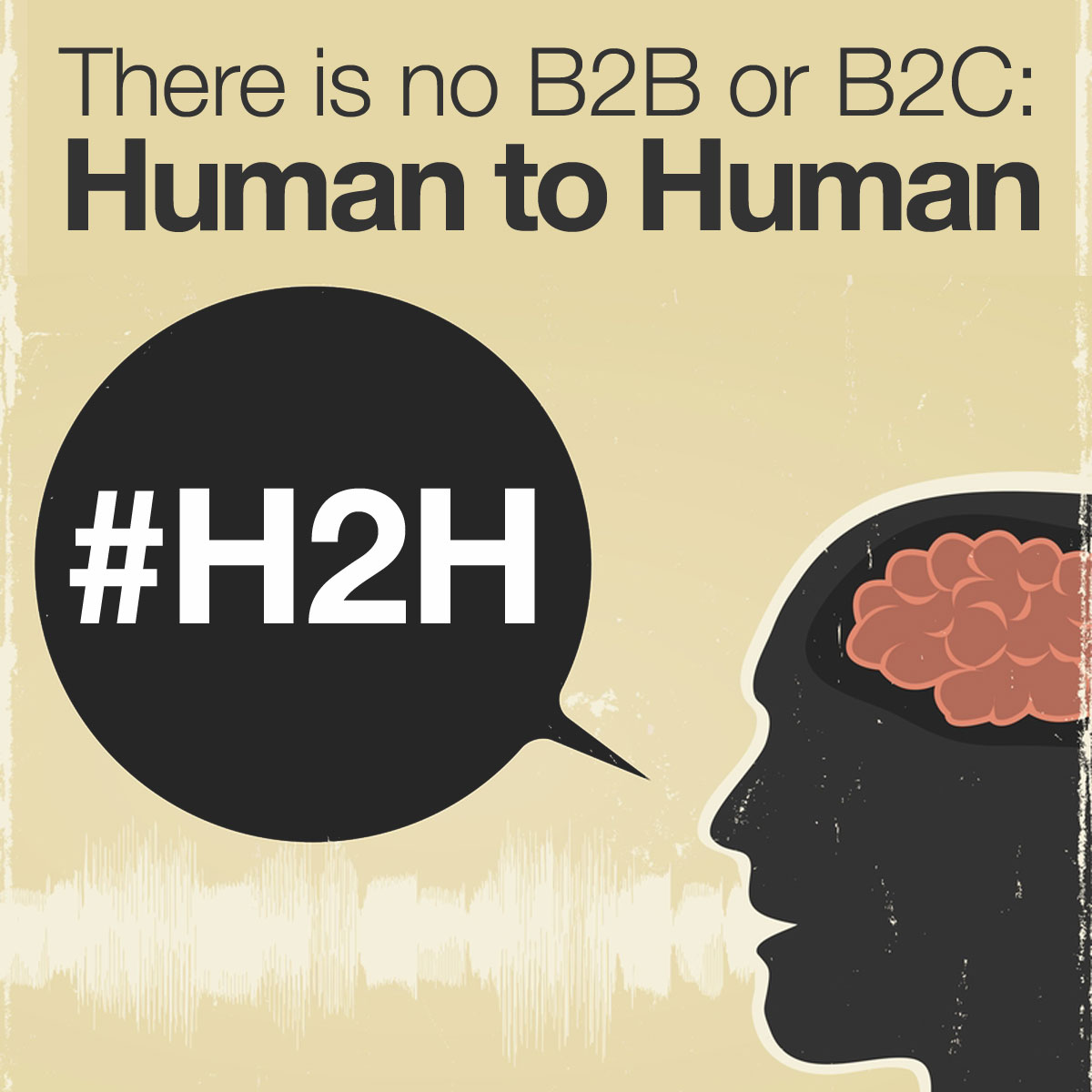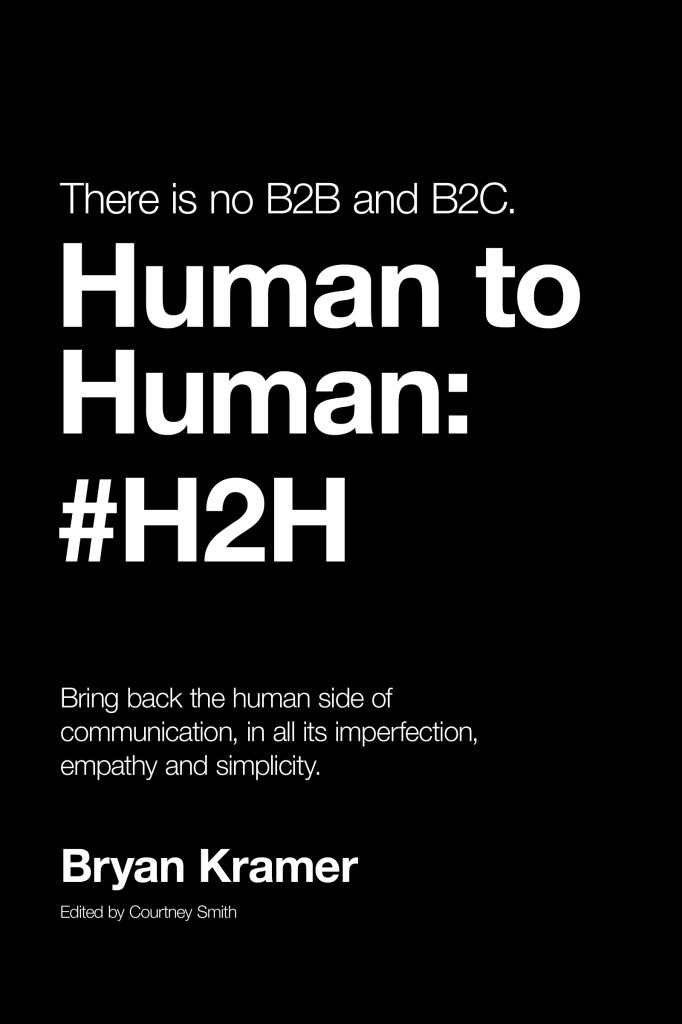
Guest post by Bryan Kramer, author of the new ebook, “There is no B2B or B2C: Human to Human” and CEO of PureMatter
Marketing has become so complex, in segmenting audiences into “B2B” (business to business) and “B2C” (business to consumer). Being here in Silicon Valley, surrounded by titans of technology like Google, Facebook, Cisco, Twitter, LinkedIn and eBay to name a few, I’ve observed a downhill slope of complexity in marketing communication. This, plus the rise of social, digital and mobile channels, have created an atmosphere of anonymity, and the entire marketing ecosystem felt like a very cold, distant and impersonal place.
I fear that the social/digital/mobile world has created an angry mob of anonymous reactors who take short form communication literally. Until we learn to be mindful of what and how we share – what I call our “social body language” – and exercise our human empathy toward the mistakes and failures of strangers and the people we know, the online world of communication will remain somewhat of the “Wild West.”
That’s where “H2H” came from; we’ve been saying it in our agency, PureMatter, for over a decade. It’s also lived in many forms from many people, most popularly with P2P (person to person or people to people). Doc Searls (Cluetrain Manifesto + VRM), Chris Heuer, Christopher Carfi, Brian Solis and many others have been talking about how the dawn of a more social web, i.e. forums, discussion boards, and pre- Web 2.0 online communities, would eventually equalize the media landscape and give a voice and brand to customers while introducing the need for a human persona in business. As Brian says of P2P, “people are now brands and brands are now people.” And, most recently, Humanize by Jamie Notter and Maddie Grant, shared the benefits of people-focused businesses and how to lead the shift from the inside out.
This evolution has been guiding our society back into one that requires a more personal approach. It is time for a reminder about our humanity.
Speaking Human
Consumers are confused. Why can’t we make it simple for people to understand what we’re selling, so they can more easily share their experiences and the value they felt with others? More importantly, why is it that what we’re marketing most often does not align to actual consumer experiences? I don’t care what language you speak, who your brand is or what message you’re trying to send, we all need to speak more human. Too often we complicate what we’re trying to say. Ironically, as our world becomes more customer-owned and socially enabled, we continue to see complicated, redundant, over-technical, and over-thought mass messages getting pushed out – and lost – in the ether. Is it really getting harder to stand out, with so much data and information out there… or is the answer just to clearly say what you mean, in understandable human words?A Human Approach: Social Sensory Marketing
Humans are social creatures; this is something we all know and understand. I had the pleasure of interviewing Scott Hebner, VP of Social Business at IBM, and friend Kare Anderson, author, speaker, columnist and coach, about how human behavior fits into the context of social marketing. Given that humans consume socially, I wondered where social marketing is headed as it continues to mature. Both Scott and Kare explained in their own ways that the future of social marketing involves “human sensory building”, and how it will become necessary to intertwine this approach into the marketing experience at each stage of the customer lifecycle. When we are able to weave directly relatable human experiences into social situations, it changes how we share and consume information forever. Human Sensory Building means connecting marketing to our most basic human sensory system. The more you can map what you’re communicating to these senses, the deeper and more meaningful your connections will be.Customers are Fickle Humans
Customers, as humans, are fickle and are so empowered today that they expect extraordinary, over-the-top experiences that rock their world. Nothing less will do. Gone are the days where feedback was kept quiet and experiences were collected around a review form. Today, your customer’s comments are transparent to your competitors, making it easier for them to publicly see your pain points. Comparisons are easier to make and product switching happens faster than ever. Customers are ready to move on unless they have one thing – an undying relationship with a person or people at your brand who made them feel uniquely special.Becoming Better Storytellers
Between the convergence of social, mobile and digital technologies, the way we have learned as humans to communicate with each other has changed forever. Texting has enabled us to eliminate face to face, or at least mouth to ear, communications in short bursts. Character limits, like on Twitter, force us to be more succinct about the words we share with the public. Over 90% of human communication is conveyed through visual body language cues. So what happens, when technology leaves us with just under the remaining 10% of verbal non-visual communication, is a floodgate of communication without context. This is a huge problem that’s rewiring our human brains, in my opinion. Humans require context to understand concepts. Without boundaries, short bursts of communication, coupled with a faster-paced, noisy society and shorter attention spans is affecting how we, as humans, tell stories.We need to become better storytellers. A commonality between humans is our emotions; we can’t help crying when others cry, laughing when others laugh. You can’t expect anyone to connect with your content, message, brand, values, if you don’t yourself. It’s that simple. Storytelling is a great way to communicate how you feel, or how you want your audience to feel. A story helps us understand how things fit into our individual experiences and gives us context to make decisions. Stories add the color, personality and relevance about what you’re trying to sell.
Technology and unsexy products will never go away and need to be sold, but shiny pieces of metal on their own will never be as interesting as the human interpretation of why they exist. 52% of consumers stop following a business’ page because the content is boring and repetitive (source: SMI). So make your marketing interesting. Create a mood through imagery. Speak at your audience’s level. Be smart and clever when you can. Tell me, don’t sell me.
These topics and many more are discussed and explored in Bryan’s recently released book: Human to Human #H2H, available on iTunes and Amazon


No hay comentarios.:
Publicar un comentario